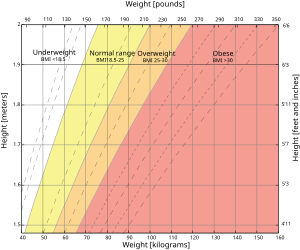Body mass index

Based on World Health Organization data here.
The body mass index (or BMI) is a measure which shows whether people have the right weight for their height. The World Health Organisation (WHO), governments and health workers use it. It is also sometimes called the Quetelet index.
History
[change | change source]The BMI was invented by Adolphe Quetelet between 1830 and 1850.[1]
A scientist named Ancel Keys first used the term body mass index in 1972.[2] He wrote that governments should measure the BMI of adults to find out whether they are too fat or too thin.
Calculation
[change | change source]To find somebody's BMI:
- measure their weight (body mass) in kilograms or pounds
- measure their height in meters or inches
- divide their weight by the square of their height
- if using pounds and inches, multiply the answer by 703
This is the formula:
For example, a man whose weight is 78 kg (172 lb) and height is 1.83 m (6 ft 0 in) has a BMI of:
A man whose weight is 172 lb (78 kg) and height is 72 inches (180 cm) has a BMI of:
Overweight or not
[change | change source]Health organisations, including the World Health Organisation (WHO), use the BMI to help decide whether people are too fat or too thin. The WHO uses these numbers for adults:[3]
| Category | BMI range |
|---|---|
| Seriously Underweight | less than 16.49 (--16.49) |
| Underweight | between 16.5 and 18.49 (16.5--18.49) |
| Normal | between 18.5 and 24.99 (18.5--24.99) |
| Overweight | between 25 and 29.99 (25–29.99) |
| Obese | 30 or more (30--) |
Some people disagree with these numbers. Some experts think the Overweight range for people with Asian body types should be 23–27.49, not 25–29.99.[4] Some experts think the lowest Normal BMI should be 20 for men, and 18 for women. The old BMI definition of overweight was 27. This changed in 1998.
Uses
[change | change source]BMI is useful for governments who want to know about the health of their people. For example, in the United States in 2007, 74% of adults had a BMI above 25 (Overweight or Obese) and 27% of adults had a BMI above 30 (Obese).[5] Many of these people will become ill because they are too fat. This information helps the United States government decide what to do about the health of its people.
BMI is less useful for finding out whether one person is too fat or too thin. BMI does not say how much weight is fat, how much is muscle and how much is bone. For example, many athletes have a high BMI. They are not fat. Their BMI is high because they have lots of heavy muscle. Other people have lots of fat and not much muscle. They are too fat but their BMI is normal.[6]
Even so, BMI is popular. It is easy to use and easy to understand, and it gives useful information for people with "normal" bodies.[7]
Variations
[change | change source]The Ponderal Index is similar to the body mass index, but the height is cubed, not squared. The formula is:
Some experts suggest that the exponent should be between 2.3 and 2.7.[8] The best formula might be:
References
[change | change source]- ↑ Eknoyan, Garabed (January 2008). "Adolphe Quetelet (1796-1874)—the average man and indices of obesity". Nephrol. Dial. Transplant. 23 (1): 47–51. doi:10.1093/ndt/gfm517. PMID 17890752.
- ↑ Keys, Ancel; Fidanza, F; Karvonen, MJ; Kimura, N; Taylor, HL (July 1972). "Indices of relative weight and obesity". J Chronic Dis. 1. 25 (6): 329–43. doi:10.1016/0021-9681(72)90027-6. PMID 4650929.
- ↑ "BMI Classification". World Health Organization.
- ↑ "Revision of Body Mass Index (BMI) Cut-Offs In Singapore". Archived from the original on 2010-03-30. Retrieved 2006-01-31.
{{cite web}}: More than one of|archivedate=and|archive-date=specified (help); More than one of|archiveurl=and|archive-url=specified (help) - ↑ Early Release of Selected Estimates Based on Data From the January-June 2007 National Health Interview Survey (12/2007) (PDF), CDC NCHS, 2007-11-19, retrieved 2008-03-15
- ↑ Romero-Corral, A.; Somers, V. K.; Sierra-Johnson, J.; Thomas, R. J.; Collazo-Clavell, M. L.; Korinek, J.; Allison, T. G.; Batsis, J. A.; Sert-Kuniyoshi, F. H.; Lopez-Jimenez, F. (June 2008). "Accuracy of body mass index in diagnosing obesity in the adult general population". International Journal of Obesity. 32 (6): 959–956. doi:10.1038/ijo.2008.11. PMC 2877506. PMID 18283284.
- ↑ Beyond BMI: Why doctors won't stop using an outdated measure for obesity., by Jeremy Singer-Vine, Slate.com, July 20, 2009
- ↑ "Calculation of power law relationship between weight and height" (PDF).
Other websites
[change | change source]- U.S. National Center for Health Statistics:







